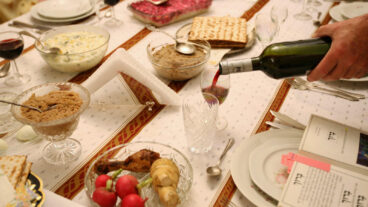The Coster family submerge themselves in kids play – Every idea just comes.Few kids make it through childhood these days without ever playing the classic game ‘Guess Who?’
The guessing game, where players ask their partner whether the funny person on the card they are holding has blond hair, brown eyes, or if they are wearing a hat, has joined games like Monopoly and Candyland: no longer just another board game, they have become classics, manufactured in numerous countries, and played and enjoyed by children around the world.
The idea for ‘Guess Who?’ – along with more than 145 other concepts that have entered children’s toyboxes and closets – emerged from the creative minds of the Coster family of Tel Aviv, who have made it their business to bring more fun and games to the world, through their company Theora Design.
Theora Design is simultaneously a small family business and a world leader in the invention and design of toys, games, crafts, dolls and other novelties. The company is essentially a toy incubator – coming up with original ideas and collaborating with top Israeli toy inventors on their ideas. Their North Tel Aviv office is a beehive of brainstorming and experimentation, trial and error that produces concepts that have been licensed to toy manufacturers worldwide, and in a lucky few cases, grown into products that are household names.
The business was founded in 1965 by Theo and Ora Coster, a young Tel Aviv couple. Ora was an arts and crafts teacher and artist, and Theo a self-taught industrial designer.
Ora Coster says that she has been inventing games as long as she can remember.
“I grew up on kibbutz, in very hard times,” she told ISRAEL21c. “There was nothing on kibbutz. Nobody had anything, so we made our own games.”
Her first game idea that made it to the marketplace came to her after she was married, and pregnant with her second child. Put on bedrest, she made up a game to keep her older son entertained during her confinement. He had wanted to know where various cities were in Israel, but couldn’t yet read – so she created a map game for him.
A family friend who owned a chain of gas stations, dropped by to visit, saw mother and son playing the original game and asked if he could reproduce Ora’s game to give away to his customers.
It turned out that they had unwittingly discovered a niche that was unfilled in Israel, and that became the beginning of the business they named Matat (Hebrew for gift), inventing and producing items for businesses that wanted to give away toys and novelties to their customers.
Many of Matat’s creations were for banks that were marketing savings plans for children and wanted a gift to give to children when the accounts were opened.
When Matat was two years old, the Costers were approached by another acquaintance, a book agent, who suggested that they try to sell some of their more successful toy and novelty ideas abroad. They agreed, and gave him three products to show at a toy fair.
“We gave him three products, and he came back with three contracts,” said Ora. “We realized that there was something to this.”
The company’s real turning point was the result of an ice cream stick.
Their agent took an idea of a building toy based on a notched stick to the 1968 Nuremberg toy fair. The basic unit – the stick – wasn’t to be sold, however it would be given away as a stick holding an ice cream or Popsicle. The idea was purchased by Borden Dairy, which, beginning in the 1970s and over the course of 11 years, produced and sold more than 12 billion ‘Elsie Stix’ inside their ice cream. The idea has been imitated by ice-cream makers world wide, eager to motivate children to keep buying their brands by offering them the chance to collect more sticks.
The tremendous success of Elsie Stix – and the resulting royalty checks – gave Theo and Ora the security to focus their efforts on inventing more toys.
Despite their global reach, the company has always been, and remains, a tiny enterprise limited to family members. In 1981 and 1993 respectively, Ora and Theo’s sons, Boaz and Gideon joined the creation and development team. Boaz’s wife, Aliza, manages the finances.
All of the original new toy ideas come from one of the four Costers – primarily Ora. Alternatively, new ideas originate from one of the 50-100 entrepreneurs with whom they meet each year. The would-be toy inventors from this group present their ideas, and the Theora team collaborates with the best of them to polish and develop an idea to bring to one of the major American or European toy companies.
“We start with an idea, and first we look to see if there is anything in it, and make sure it is a new idea. I am the research person, I have loads of catalogues, so I can know what’s already been done, so we don’t waste time doing it again,” explains Boaz Coster.
Once an idea is deemed worthy, a rough model is made and tested on a focus group of kids the right age.
“If we are satisfied and the group has no major objections to the game, we build a final industrialized model,” he says.
The North Tel Aviv offices are equipped with a pantographic engraving machine, various types of molds, in order to produce a professional-looking model. That model is taken abroad – to the headquarters of major toy manufacturers worldwide and to the major annual toy fairs.
“In the first stage, we meet with the product acquisition person in those companies,” Boaz explains. “It can then take six months to two years for the company to put a game through market researching, child testing, safety and pricing and decide if they want to manufacture it.”
Even when a game is manufactured, its shelf life is far from certain. The overwhelming majority of toys and games fail – or only thrive for a year or two, and disappear shortly thereafter. Only a lucky few, go on to become classics.
The company’s biggest success, is, by far, ‘Guess Who?’ The highly popular game requires players to guess which character their opponent is holding based on their hair color, eye color and clothing is also frequently used by speech therapists to help teach children how to phrase questions.
Another familiar name is Play-On-Wordz by Hasbro. Play-On-Wordz, known in Israel as Magimixer, was created by an accident that Ora Coster had while cleaning up.
While arranging her desk, a die fell into a plastic round-hole stencil. She noticed that the die had ‘locked’ into the stencil, yet it could move and rotate, and that it was fun to shift it around by rubbing it between her hand. She made a model of a new dice game based on the concept – Theo, who was in charge of models, was serving in the Israeli army reserves at the time. When he came back, he perfected the industrial design, and the unique flower-shaped game has become a board game staple ever since.
It’s hard for Ora to explain where the ideas come from. As with any creative process, it can be unpredictable. “Every idea just comes, you can’t just sit down and decide, I’m going to invent something today.”
Some of her best ideas stem from her sheer practicality – she tries to design toys with as few loose parts as possible that require little cleanup and reduce the chances of important pieces of the game getting lost: the stabilized dice in ‘Play-On-Wordz’ and the flip-up board for Guess Who are excellent examples of this.
In the case of Guess Who – she had worked to perfect the game for two years, and the idea was turned down by numerous companies, including Milton Bradley, the company that eventually took it. The key selling point was the special board.
Ora confesses that even though she works to come up with marketable ideas, she is not a businesswoman. “Money is not important to me,” she says – what is important to her is that her games catch on and that people enjoy playing them.
As the sources of entertainment multiply, Theora cannot afford to rest on its laurels: it is a continuing challenge to come up with board games and crafts that can compete with the growing number of electronic distractions for children and adults.
Yet Boaz Coster says he doesn’t feel threatened by computers, Gameboys, or Playstations.
“As far as we can see, there will always be a market for sociable, playable human games, where you share the joy of winning and losing and see the reactions on the faces of the people you are playing with,” he says. “There is no electronic substitute for that.”












